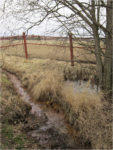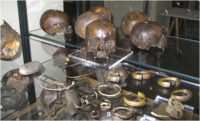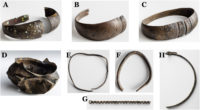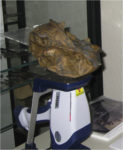Analysis of metal artifacts found at the Iron Age water burial site in Levänluhta, western Finland, has revealed links to an extensive exchange network stretching across Europe. This is the first-ever lead isotope analysis of copper artifacts found in Finland, and it sheds new light on the movement of materials through Europe in the Iron Age.
 With at least 98 individual burials (a DNA study published earlier this month found they were closely related to the current Sámi people, the first physical evidence of Sámi settlement in southern Finland), Levänluhta is the largest water cemetery in Finland. It’s also unusual in that most of the people buried there (there are animal bones among the assemblage as well) were women and children, and they were buried whole instead of being cremated which was the common burial practice in Finland at the time. There’s no evidence of human sacrifice on the remains, no sharp or blunt trauma, nor is there evidence on the bones that they died from illness or famine. The water cemetery was in use from 300-800 A.D. when it was a small pond; today it’s a wetland.
With at least 98 individual burials (a DNA study published earlier this month found they were closely related to the current Sámi people, the first physical evidence of Sámi settlement in southern Finland), Levänluhta is the largest water cemetery in Finland. It’s also unusual in that most of the people buried there (there are animal bones among the assemblage as well) were women and children, and they were buried whole instead of being cremated which was the common burial practice in Finland at the time. There’s no evidence of human sacrifice on the remains, no sharp or blunt trauma, nor is there evidence on the bones that they died from illness or famine. The water cemetery was in use from 300-800 A.D. when it was a small pond; today it’s a wetland.
 No pottery was found, but there were 22 metal objects buried with the remains. Most of them were jewelry — finger rings, arm rings, neck rings, brooches, a chain — plus a bronze cauldron and some metal rods of undetermined nature. They date to the Merovingian period (ca. 550–800 A.D.) and the design and decoration styles indicate they were created in local workshops in Finland, but Finland didn’t have native sources of copper during the Bronze and Iron Ages, and no evidence of metal workshops or even settlements has been found near the Levänluhta site. Until recently scholars believed the ore itself was imported from southern Sweden. However, studies in the past few years have found that the metal in Iron Age artifacts discovered in Sweden were also imported from elsewhere.
No pottery was found, but there were 22 metal objects buried with the remains. Most of them were jewelry — finger rings, arm rings, neck rings, brooches, a chain — plus a bronze cauldron and some metal rods of undetermined nature. They date to the Merovingian period (ca. 550–800 A.D.) and the design and decoration styles indicate they were created in local workshops in Finland, but Finland didn’t have native sources of copper during the Bronze and Iron Ages, and no evidence of metal workshops or even settlements has been found near the Levänluhta site. Until recently scholars believed the ore itself was imported from southern Sweden. However, studies in the past few years have found that the metal in Iron Age artifacts discovered in Sweden were also imported from elsewhere.
All 22 metal artifacts were recently analyzed using portable energy-dispersive X-ray fluorescence spectrometry (pXRF) analysis, a non-invasive technology that determines metal composition. They were found to be copper or copper alloys (bronze and brass).
 Eight of the pieces recovered from Levänluhta were analyzed using multi collector inductively coupled plasma mass spectrometry (MC-ICP-MS) to determine their lead isotope content. By comparing the lead isotope ratios in the artifacts to those found in domestic, Swedish and other European copper ores, scientists hoped to discover the origin of the raw material and trace their provenance.
Eight of the pieces recovered from Levänluhta were analyzed using multi collector inductively coupled plasma mass spectrometry (MC-ICP-MS) to determine their lead isotope content. By comparing the lead isotope ratios in the artifacts to those found in domestic, Swedish and other European copper ores, scientists hoped to discover the origin of the raw material and trace their provenance.
Based on typology, the oldest piece of the eight was a small arm-ring with a flattened end (ca. 100 A.D), followed by the Westland-type cauldron (300-575 A.D.) and the piece of chain (ca. 400 A.D.). The other five objects analyzed were arm rings and neck rings dating to the same late Iron Age (550-800 A.D.).
 MC-ICP-MS requires samples of the metal to work, so it is invasive, but researchers were able to make it minimally so drawing samples of just 7-10 mg. Because the samples were microdrilled from the artifacts, surface issues — wear, patina, corrosion — did not affect the results like they do pXRF analysis. The lead isotope and trace evidence found that the source of the copper ore was neither Finland, nor Sweden nor anywhere else in Scandinavia.
MC-ICP-MS requires samples of the metal to work, so it is invasive, but researchers were able to make it minimally so drawing samples of just 7-10 mg. Because the samples were microdrilled from the artifacts, surface issues — wear, patina, corrosion — did not affect the results like they do pXRF analysis. The lead isotope and trace evidence found that the source of the copper ore was neither Finland, nor Sweden nor anywhere else in Scandinavia.
Based on the lead isotope ratios, the copper in the objects has its origins in the copper ores found in Greece and Bulgaria. These regions produced a large quantity of copper in the Bronze and Iron Age, which spread around Europe as various object forms, distributed as presents, loot and merchandise. Metals were also recycled by melting old objects into raw material for new casts. It may be possible that metals that ended up in Finland during the Bronze Age were recycled in the Levänluhta region.
The findings of this project, funded by the Emil Aaltonen Foundation, demonstrate that products of the copper exchange network of continental Europe also reached Finland across the Baltic Sea, thus making it possible to link the region with the extensive copper exchange system known to have extended throughout Europe. The results also illustrate the temporally and technologically multi-layered nature of prehistoric metal artefacts: raw materials found their way here through a number of hands, most likely over a long period of time and across very great distances. In domestic artisan workshops, these metals of international origin were manufactured into pieces of jewellery in domestic Iron Age fashion, perhaps embodying the local identity and place of residence of the bearer.
The lead isotope study has been published in the Journal of Archaeological Science: Reports and can be read in its entirety online.
If there is really no evidence of human sacrifice on the remains, and no sharp nor blunt trauma on the bodies in that Finnish ‘water cemetery’, this could be explained in case they all had been ..drowned :no:
Moreover, without a widespread trade in copper, tin, amber –etc.– there would have been hardly an kind of ‘Bronze Age’ to start with, would it? 😉
The ‘Gesta Hammaburgensis ecclesiae pontificum‘, the “Deeds of the Bishops of Hamburg” (1073 A.D. to 1076 by Adam of Bremen) cover in Bk.IV the Arctic North (‘Descriptio insularum aquilonis’: Geographical description of Northern Europe), incl. Sámi-Viking contacts, Iceland, Greenland and in chapter 39 Winland (North America), reported by the king of the Danes:
———
..Tercia est Halagland insula vicinior Nortmanniae , magnitudine ceteris non impar. Haec in estate circa solsticium per quatuordecim dies continuos solem videt super terram et in hieme similiter per totidem dies sole caret. Stupenda res et incognita barbaris, qui nesciunt, disparem longitudinem dierum contingere propter solis accessum et recessum. Nam propter rotunditatem orbis terrarum necesse est, ut solis circuitus accedens alibi diem exhibeat, alibi recedens noctem relinquat. Qui dum ascenderit ad aestivale solsticium, his qui in borea sunt dies prolongat noctesque adbreviat; descendens autem ad hiemale solsticium, simili ratione facit australibus. Hoc ignorantes pagani, terram illam vocant sanctam et beatam, quae tale miraculum praestet mortalibus. Itaque rex Danorum cum multis aliis contestatus est hoc ibi contingere, sicut in Suedia et in Norvegia et in ceteris quae ibi sunt insulis.
Praeterea unam adhuc insulam recitavit a multis in eo repertam oceano, quae dicitur Winland, eo quid ibi vites sponte nascantur, vinum optimum ferentes. Nam et fruges ibi non seminatas habundare, non fabulosa opinione, sed certa comperimus relatione Danorum. Post quam insulam, ait, terra non invenitur habitabilis in illo oceano, sed omnia, quae ultra sunt, glacie intolerabili ac caligine immensa plena sunt. Cujus rei Martianus ita meminit: Ultra Thilen, inquiens, navigatione unius diei mare concretum est. Temptavit hoc nuper experientissimus Nordmannorum princeps Haraldus. Qui latitudinem septentrionalis oceani perscrutatus navibus tandem caligantibus ante ora deficientis mundi finibus, inmane baratrum abyssi retroactis vestigiis vix salvus evasit.
..The third enclosure is Halagland closer to Nortmannia, in size not different from the others. Around solstice, this one sees in Summer for fourteen days the sun constantly over the land, and in Winter similarly for the same amount of days it completely lacks any sun. It is this a shocking and strange thing to the Natives, who do not know that the uneven length of days is caused by the access and recess of the sun. Moreover, the round shape of the globe necessitates that the course of the accessing sun brings day, and otherwise the recessing sun leaves night. As it accesses to summer solstice, it prolongates the days and shortens the nights to those that are in the North; and while it descends to winter solstice, it brings the corresponding to those in the South. Unaware of that, the pagans call that land holy and happy, because it presents those miracles to the mortals. This has now been confirmed by the king of the Danes and many others happening there as it does in Sweden and in Norway and the rest of the islands over there.
“Additionally, he lets us know about a newly found island among the many in that ocean, which is referred to as ‘Winland’, because grapevines grow there on its own, bearing the best vines. That over there the abundant crops are not sown, we get to know not only from fanciful opinion but from the true account of the Danes. Beyond that island, he says, habitable land is not found in that ocean, instead all territories beyond are full of intolerable ice and immense fog. On this, Martianus comments as follows: One day of sailing beyond Thule, he says, the sea is frozen. Harald, the most enterprising leader of the Normans, recently tried that. He who searched with his ships the northern latitude at last backed down safely from the nebulous harsh extreme end of the world, hardly avoiding tha vast abyss of Hell by reversing his track.”
———
[Ribes hudsonianum / Hudson Bay currants are found in every province in Canada, from Quebec westwards; and parts of the US, Alaska, the Great Lakes region, the northern Rockies, Cascades, Blue Mountains, and other parts of the Northwest. Alegedly, the Algonquin people use Ribes glandulosum as food, but it remains unsure if that counts as vine.]
:hattip:
—
P.S.: His description of the temple at Uppsala in Sweden is one of the most famous excerpts of the Gesta: “In this temple, entirely decked out in gold, the people worship the statues of three gods in such wise that the mightiest of them, Thor, occupies a throne in the middle of the chamber; Wotan and Frikko have places on either side. (…) Thor, they say, presides over the air, which governs the thunder and lightning, the winds and rains, fair weather [and] crops. The other, Wotan – that is, Fury [Wodan, id est furor] – carries on war and imparts to man strength against his enemies. The third is Frikko, who bestows peace and pleasure on mortals. His likeness, too, they fashion with an immense phallus.”
…“Vitis riparia, riverbank grape or frost grape, is a native American climbing or trailing vine, widely distributed across central and eastern Canada and the central and northeastern parts of the United States. While Vitis riparia shares many important characteristics with its cousin, Vitis vinifera, the small size of the berry (making it prone to predation by birds), the high acidity of its fruit (often up to 5% titratable acidity), the intense pigment of its juice, and the presence of herbaceous aromas in wine produced from it have made it unusable on its own for commercial viticulture. Vitis riparia is sometimes used to make flavorful homemade jellies, jams, and wine. Perhaps the most significant agricultural usage of V. riparia is as grafted rootstock for Vitis vinifera.”
..Cheers! 😀